Roland JUNO-X: The modern Roland polysynth we’ve been waiting for?
The JUNO-X combines iconic JUNO-106 styling with Roland’s advanced ZEN-Core synthesizer engine. It offers a vintage experience with huge sound potential. Has Roland nailed it with this one?
Roland JUNO-X
I have to admit the JUNO-X is triggering all sorts of feelings and ticking all sorts of boxes for me at the moment. Opening the folder of photos I was wincing slightly to prepare myself for the terrible things I imagined Roland might do to this classic synthesizer. I could not be more wrong. The JUNO-X looks fantastic. There are no weird extras, crazy touch screens, horrible backlighting or bizarre design choices. It is solidly a Juno, thank the god of synthesizers.
It’s picked up a few things from the software emulations that have given us a flavour of the JUNO-106 over the years like more effects and a bit of reordering. And you’ve got the arpeggiator from the JUNO-60, albeit the JUPITER-X enhanced version. But it is so damn recognisable.
Behind the scenes of course this is not an analogue synthesizer, it’s an emulation of its own. It’s built on Roland’s futuristic ZEN-Core platform that recreates analogue circuits behaviour (thank you commentators) and dynamics down to the finest details. But this allows this synthesizer to be much more than a JUNO-106. So, you get the JUNO-106 emulated by the people who built the original and the hardware to control it. You also get the more punchy JUNO-60, a PCM-based XV-5080 section, pianos from the RD series and a vocoder all accessible from the front panel. But those are just the crowd-pleasers because the JUNO-X has its own thing going on and then opens it all up to the Roland Cloud Model Expansions.
Synth Engine
The JUNO-X is a new synth engine with a Super Saw waveform and enables features such as velocity sensitivity, pitch envelope control and more. It massively expands the effects section around the two classic Chorus modes of the original. You can use up to seven different chorus effects on any JUNO-X tone. You can load up to 4 tones for layering from the 4,000 presets and one rhythm part from the 90 drum kits.
For connections, we find balanced and line-level outputs, MIDI I/O, a stereo input and a mic input for the vocoder. It can be a USB Audio Interface and take thumb drives right in the back. It has integrated Bluetooth and the WC-1 wireless adapter for Roland Cloud Connect and easy transfer of sounds and expansions. The keyboard is 61 notes and has channel aftertouch.
The great thing about the original Junos is that they were easy to use. The JUPITER-X and XM which also feature the ZEN-Core engine have come across as quite complex machines. Let’s hope that the JUNO-X manages to be more intuitive and accessible. Price-wise it sits between the two Jupiters at around £1700 which is probably disappointingly expensive for many of us, but it does look like a fabulous machine.

You are currently viewing a placeholder content from YouTube. To access the actual content, click the button below. Please note that doing so will share data with third-party providers.
23 responses to “Roland JUNO-X: The modern Roland polysynth we’ve been waiting for?”

 4,9 / 5,0 |
4,9 / 5,0 | 
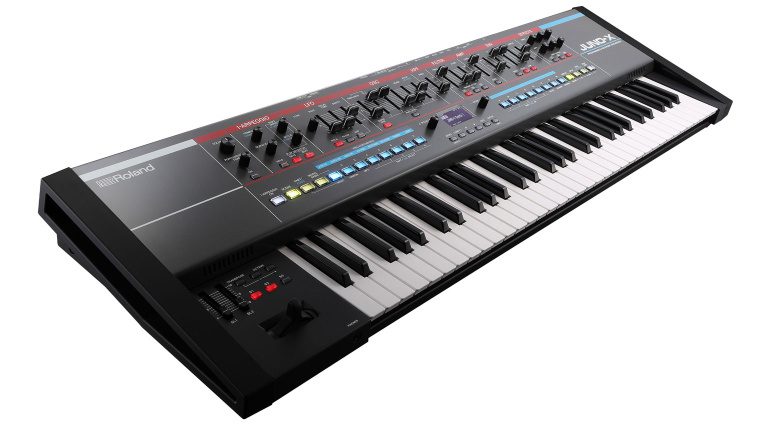
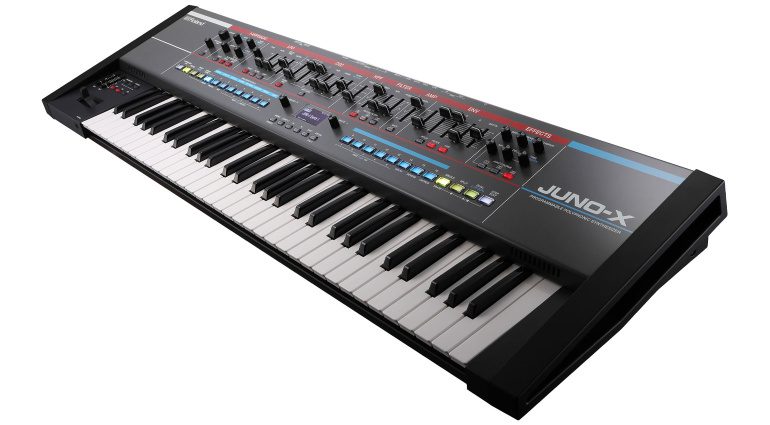
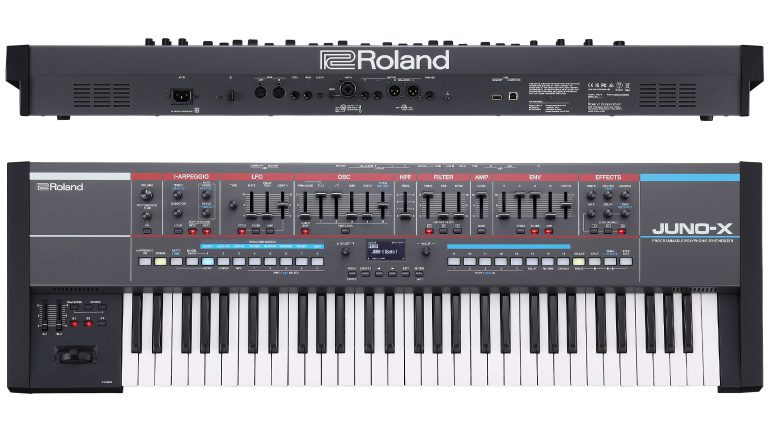









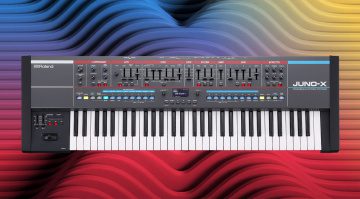

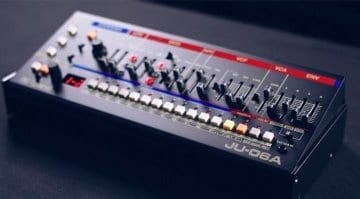
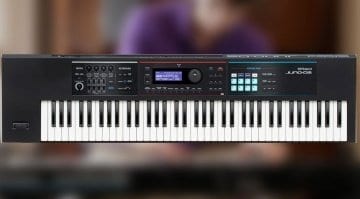
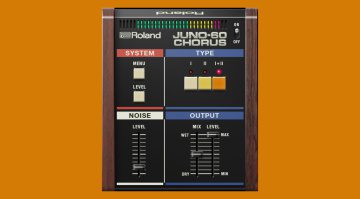

“It’s built on Roland’s futuristic ZEN-Core platform that recreates analogue circuits and systems down to the finest details. ”
That’s incorrect. ZEN-core is not ACB. Roland has been very careful with their marketing and specification language to not call ZEN-core a component level modeling engine.
ZEN-Core is the platform upon which Roland runs its new partial based synthesis engine, virtual analogue, PCM and the modelling of old synths. So strictly speaking the ZEN-Core platform doesn’t do the recreation, it runs the models that do. From Roland’s ZEN-Core docs – “Precisely modeled oscillators and filters can be mixed and matched for unique combinations” – https://www.roland.com/us/promos/zen-core/
ZENCore uses ABM (Analog Behaviour Modeling) while System-8 uses ACB (Analog Circuit Behaviour). Big difference: ABM requires less CPU power than ACB. These are two different technologies.
I mentioned neither
Correct and that is not component level modeling as advertised in this article. ACB is Roland’s component level (circuit board) modeling technology.
Ah, ok, it’s the word “component” that’s bothering you. I’ve corrected it in the article – thanks for the persistence 😀
Thanks for hearing me out. As a big fan of the original Juno 106, the plug-out in the Roland Cloud and System 8 platforms, and even the little Ju-06 – I was really excited about this release but disappointed they went with ZenCore for the sound engine. I wanted to love ZenCore in RC, Jupiter X, and even the MC707 but I just can’t sculpt the same tones and sweet spots I can with all the other ones I mentioned (ACB, OG 106, etc..) At the core of the disappointment is that whole component level modeling versus pre-canned JUCE libraries that Roland keeps pursuing for these instruments.
I’ll keep my fingers crossed for a System 8 MK2 with an ACB Juno 106 plug-out.
“System 8 MK2 with an ACB Juno 106 plug-out” that is a very interesting prospect.
I am sure OP recalls this same text that did killed my interest, originally from SOS review of Jupiter X:
https://www.soundonsound.com/reviews/roland-jupiter-x
“Now let’s look at the physically modelled engines. These are not based on the ACB algorithms used in the System 8 but on a less power-hungry technology called ABM (analogue behaviour modelling). Roland describe ACB as being ‘ultra-precise’ whereas ABM offers ‘a more holistic and dynamic recreation’ of vintage synthesizers; in other words, the company’s engineers have attempted to obtain similar results without modelling in as much detail as before. So… how successful have they been?
I compared the Jupiter engine in the Jupiter X to my Jupiter 8. Not to put too fine a point on it, the ABM engine sounds gorgeous but it’s not quite as accurate as the ACB version. However, I’m not about to complain about the difference, especially since the ABM engine offers a maximum of 32-note polyphony, responds to velocity and aftertouch, has a slightly expanded parameter set and has a wider range of values for the LFO rate as well as the filter cutoff frequency, resonance and filter envelope depth, all of which add to the engine’s capabilities without in any way detracting from its Jupiter-i-ness. What’s more, despite some significant differences in the layouts of the two synths, programming the Jupiter X can feel much like programming a Jupiter 8, and that’s no minor accolade.
The same is true of the Juno engine. While the ABM parameter map is more accurate to the original than the ACB map, there are occasions when it doesn’t quite hit the spot. For example, the Junos’ organs (created using the sub-oscillator for the 16′ drawbar, the oscillator for the 8′ drawbar, and the self-oscillating filter for the 5-2/3′ drawbar) are classic sounds, but the Jupiter X doesn’t recreate them perfectly because the filter doesn’t sync to the oscillator in the same way. Furthermore, the MFX Juno Chorus isn’t quite the same. It can sound excellent, but it’s not precisely the same.”
How much “not quite the same” in your opinion?
Blatantly?
Obviously?
Somewhat, but good enough in itself?
Zen-Core is more versatile, efficient, but not as accurate as ACB in terms of analog emulation. I don’t know why they put lower grade audio engine into their highest grade synth.
At least they gave us piano and drum samples! (sarcasm) I’m bummed about this too. I wanted an ACB or analog Juno 106 on steroids – not a half-way Juno.
It looks amazing. Like a classic Juno. Too bad that’s about the extent of the similarities. Vocoder? Tone layering? Zen-core? Wish they could’ve surprised us with a modern day analog synth rather than more software emulation.
It absolutely looks the part. A ** for the design department.
But priced about the same as an immaculate, fully serviced Juno 106 which has had its chips replaced…. Hmm I’m not so sure about that one. Perhaps it’ll settle down to nearer £1200 when it hits the shops.
So close yet so far away.
Roland.. just stop.
I’ll just keep it to my Roland Juno-60 and Behringer DeepMind12.
Yeh, when you really want to love something but no. It looks very tempting but £1700 for a glorified controller with a little computer inside, – that’ll keep you tethered to Roland’s mothership, – pay for new software – and at the mercy of how long the company supports choose to support the platform. Did I get that wrong.. Sorry, but to me physical objects with any type of planned obsolescence annoys me. My Alpha Juno still works just fine. No need for user name and keyword.
Now that Oberheim on the other side…
“vintage experience”
I never understood why Roland didn’t re-issue their classics in a analogue surface-mount PCB, slightly scaled-down form. This isn’t for me, but I’m sure it will do well in whatever market it’s aimed at.
Roland has gone woke! Constant recycling of their Zen ABC crap!
Every time I want to sell my Juno-6, Roland (ACB, ABM, …whatever) reminds me not to do it.
Do I see what looks like Stereo Speaker ports (a HS-60 throwback) ? Or are they just air cooling vents?
Apparently, it has speakers, so does the Jupiter-X – weird but it does mean you can turn it on and play it.
Bought one to replace a FP1. Warm sounding and editable surface controller makes it suitable for use with a Integra7. The GM mapping remains to be reset to channel 10 from the default 5. Where to post audio demos without getting dcma’ed?
You are currently viewing a placeholder content from Facebook. To access the actual content, click the button below. Please note that doing so will share data with third-party providers.
More InformationYou are currently viewing a placeholder content from Instagram. To access the actual content, click the button below. Please note that doing so will share data with third-party providers.
More InformationYou are currently viewing a placeholder content from X. To access the actual content, click the button below. Please note that doing so will share data with third-party providers.
More Information